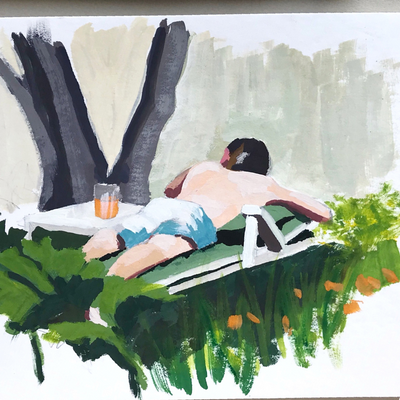How art brushes are made?
I often get asked about my favorite art supplies. One item that always comes up is paintbrushes. We all have our favorite art brushes that we love to use, but have you ever wondered how they’re made? I recently had the opportunity to visit the French brush-making factory Leonard and let me tell you; it was an eye-opening experience! In this article, I will take you on a virtual tour of the factory and share the fascinating process of making art brushes so you know how art brushes are made.
You can watch the video if you prefer:
How it started
I was looking at my favorite art supplies catalog because turning pages is more fun than scrolling on a website, and I found an intriguing brush.
This Petticoat Brush has several layers of soft hairs tightly packed together, creating a dense and fluffy head with a long tail. I loved the brush’s name (pinceau jupon in French) and was intrigued by its unique shape. So I bought one and had fun with it.

I made a reel on Instagram and TikTok and had a lot of comments and questions about it, and the video gained some traction. Until the brand community manager invited me to visit the factory, so let’s spend some days in Brittany!
The Brush-Making Process
The brush-making process is a fascinating blend of science and artistry. At Leonard, the process begins with carefully selecting the highest quality hairs for each brush. Hairs are synthetic or natural, depending on the purpose of the brush. The hairs are sorted by hand to ensure that only the finest ones are used. This critical step ensures that each brush has the perfect combination of softness and strength.

Once the hairs have been prepped, they can be shaped into brushes. This is where true artistry comes into play. Skilled artisans use various techniques to shape the hairs into the desired brush shape, from twisting and bending to pressing and cutting. Each brush is carefully crafted to ensure that it meets the strict quality standards set by Leonard.

Once the brush has been shaped, it is then assembled. Artisans carefully glue the hairs into the brush head and attach the handle with a ferrule. The handle is made from various materials, from wood to plastic, depending on the brush type.

Then, they had a gold print on the handle with all information about the brush. Finally, the brush is inspected to ensure that it meets the high standards set by Leonard.
Meaningful Experience
As an artist, witnessing the brush-making process was a truly awe-inspiring experience. Seeing the care, attention to detail and artistry that goes into creating each brush was a revelation, and it deepened my appreciation for the tools of my craft.
Watching the artisans sort through the hair, selecting only the finest ones for each brush, was a testament to their skill and dedication. Seeing how they used different techniques to shape the strands into the desired brush shape was a true marvel, and it gave me a new understanding of the importance of choosing the right brush for each artistic endeavor.

What struck me the most, however, was the sheer beauty of the process. From how the hairs glinted in the light to how the brush handles were crafted with such care and precision, there was a sense of artistry and elegance in every step of the process.
As an artist, our tools are just as important as the talent we bring to our work. Seeing the brush-making process firsthand gave me a deeper appreciation for the craftsmanship that goes into creating these tools, and it inspired me to approach my work with the same level of care and attention to detail.
In conclusion, witnessing the brush-making process was a transformative experience for me as an artist. It reminded me of the beauty and artistry that goes into creating the tools of our craft, and it deepened my appreciation for the role these tools play in our creative endeavors.
If you happen to be in Saint-Brieuc, Brittany, France, you can also visit the factory!






